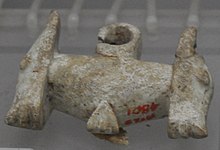


Lingling-o or ling-ling-o, are a type of penannular or double-headed pendant or amulet that have been associated with various late Neolithic to late Iron Age Austronesian cultures. Most lingling-o were made in jade workshops in the Philippines, and to a lesser extent in the Sa Huỳnh culture of Vietnam, although the raw jade was mostly sourced from Taiwan.[1][2][3][4]
The earliest surviving examples of lingling-o, dating back to around 500 BC, were made out of nephrite jade, but many later examples were also made of shell, gold, copper, and wood;[2] the different materials suggest differences in the wearer's social standing.[2] The term lingling-o was first popularized by H. Otley Beyer, who adapted it from the Southern Ifugao name for such ornaments;[5] it has since also come to be used as a blanket term for various metal age Austronesian ornaments found in the Philippines, Taiwan, and Vietnam.[5]
Although the earliest known lingling-o dates from 500 BC, the art of jade carving and its trade in the region is much older. In 2000 BC, the Maritime Jade Road was established by the animist indigenous peoples of Taiwan and the Philippines. This expansive trade network included other commodities as well, and later expanded to include Vietnam, Malaysia, Brunei, Singapore, Thailand, Indonesia, and Cambodia. The maritime jade road is one of the most extensive sea-based trade networks of a single geological material in the prehistoric world. It was in existence for at least 3,000 years, where its peak production was from 2000 BCE to 500 CE, older than the Silk Road in mainland Eurasia. It began to wane during its final centuries from 500 CE until 1000 CE. The entire period of the network was a golden age for the diverse animist societies of the region.[6][7][8][9]
- ^ Zafra, Jessica (2008-04-26). "Art Exhibit: Philippines' 'Gold of Ancestors'". Newsweek. Retrieved 2017-12-27.
- ^ a b c "National Museum Collections: Ling-ling O". Official Website National Museum of the Philippines (Beta Website). Archived from the original on 2011-11-11. Retrieved 2017-12-27.
- ^ Cite error: The named reference
hung2006was invoked but never defined (see the help page). - ^ Cite error: The named reference
Hung2007was invoked but never defined (see the help page). - ^ a b Apostol, Virgil Mayor (2010). Way of the Ancient Healer: Sacred Teachings from the Philippine Ancestral Traditions (2010 ed.). North Atlantic Books. ISBN 978-1556439414.
- ^ Tsang, Cheng-hwa (2000), "Recent advances in the Iron Age archaeology of Taiwan", Bulletin of the Indo-Pacific Prehistory Association, 20: 153–158, doi:10.7152/bippa.v20i0.11751
- ^ Turton, M. (2021). Notes from central Taiwan: Our brother to the south. Taiwan’s relations with the Philippines date back millenia, so it’s a mystery that it’s not the jewel in the crown of the New Southbound Policy. Taiwan Times.
- ^ Everington, K. (2017). Birthplace of Austronesians is Taiwan, capital was Taitung: Scholar. Taiwan News.
- ^ Bellwood, P., H. Hung, H., Lizuka, Y. (2011). Taiwan Jade in the Philippines: 3,000 Years of Trade and Long-distance Interaction. Semantic Scholar.
© MMXXIII Rich X Search. We shall prevail. All rights reserved. Rich X Search
